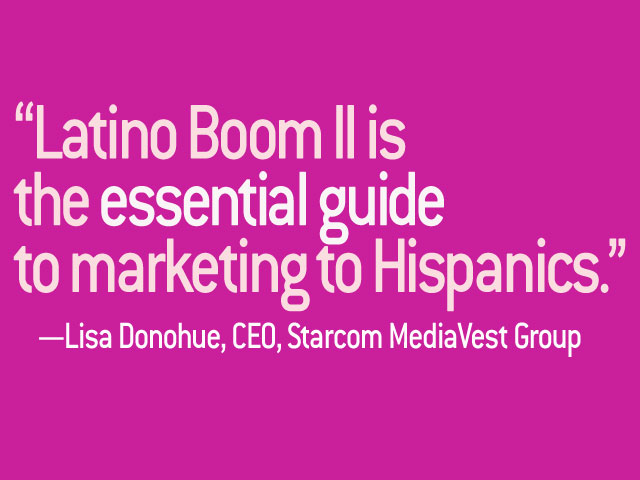INTRO and PRAISE
“Clearly written and full of data and new insights, Latino Boom II gives every marketer a better understanding of how to capitalize on the growing Hispanic consumer. Latino Boom II is a must read.”
—Bob Liodice, President and CEO, the Association of National Advertisers
“If you want to succeed as a business, you need to know how to reach and communicate to Hispanics. This isn’t something a marketer can afford to put off. As Chiqui says, the future is here. Understanding this demographic and all of its trends and nuances, smartly explained in Latino Boom II, will be the difference between marketers that win and marketers that fall behind.”
—Abbey Klaassen, Editor, Advertising Age
“Latino Boom II provides a powerful snapshot of how Hispanic consumers are redefining all facets of life in the U.S. Using a mix of interesting anecdotes and rich data, Chiqui captures the attention of readers with ease. Latino Boom II is more than a wake up call. It is a how-to guide on successfully engaging this growing consumer segment in order to deliver exponential brand growth in the new American reality.”
—Monica Gadsby, CEO, SMG Multicultural and Latin America
“For the past twenty-five years, Chiqui Cartagena has been articulating what it takes to address the Hispanic market successfully. Both as a marketer and a thought leader, Cartagena has helped uncover ways mainstream brands can use innovative thinking, strategic partnerships and content to expand into the Hispanic market.”
—Mike Hammer, ADWEEK
INTRODUCTION
In spite of all the talk about the rise of the BRIC countries (Brazil, Russia, India, China), in his book The Next 100 Years: The Forecast for the 21st Century, historian George Friedman contends that America will continue to be the dominant superpower of this relatively new century. America’s greatness is not only based on its military and economic supremacy around the globe, according to Friedman, America will continue to be powerful because of its people and the strength of our democracy. Of course, at the heart of this great country is the indomitable spirit of its citizens who came here looking for life, liberty, and the pursuit of happiness.
Let’s not forget that since its very beginning, this country has been built on the strength of immigrants. For the past nearly 230 years, the people who have come here from all over the world searching for their American Dream have made America stronger and better. No country is more diverse than the USA, and nowhere is this more visible than during the Olympics. In the parade of nations, the athletes wearing red, white, and blue uniforms are a manifestation of who we are: a truly multicultural America.
The multiculturalism that is celebrated in the sports arena has not yet permeated the political or business worlds of America. On the contrary, over the past decade the political rhetoric has taken on an extremely divisive tone. We talk about our country in terms of red states and blue states, and at heart of this clash are two demographic trends that experts say will reshape the America of the twenty-first century: on the one hand, you have an increasingly young and diverse population (in large part fueled by the Latino Baby Boom) in which minorities will soon make up a majority of the country; and on the other hand, you have the Baby Boom Generation (four-fifths of whom are white) that is massively moving into retirement after having recently suffered one of the worst economic downturns in their lives. Below the surface of these two demographic shifts are undeniable racial and cultural tensions that, according to William Frey, a demographer at the Brookings Institution, have already formed a “cultural generational gap” that will “rattle American politics for decades,” because the attitudes, needs, and priorities of each group seem to be diametrically opposed in terms of policy choices.
During the 2012 presidential elections, we saw how this cultural generational gap has started to affect the political discourse. But if you look closely, this cultural generational gap has been fueling the so-called culture wars Americans have been living over the past decade, the victims of which have often been women, gays, and now immigrants. But now this cultural generational gap is coming to a head, and as Ronald Brownstein wrote a few years ago in the National Journal, “the twist is that graying white voters who are skeptical of public spending may have more in common with the young minorities clamoring for it than either side now recognizes. Today’s minority students will represent an increasing share of tomorrow’s workforce and thus pay more of the payroll taxes that will be required to fund Social Security and Medicare benefits for the mostly white Baby Boomers.”
To read more, please click here to buy Latino Boom II.


